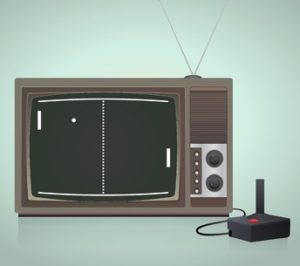By Dr. Ken Broda Bahm:

Remember “Pong?” For those of us of a certain age, it was probably the first video game we ever played, knocking that pixelated ball back and forth using a flat digital paddle. The game is interestingly the subject of a new social science study focusing on perception (Witt, Tenhundfeld & Tymoski, 2017). The study, covered in a ScienceDaily press release entitled, “Pong Paddles and Perception,” shows that people perceive the pong ball to move faster when the pong paddle is smaller. So, rather than perception being based on the neutral reception of visual information, it depends strongly on the task the perceiver is engaged in at the moment, and when one is urgently moving a smaller paddle toward the ball, the ball itself seems to be faster.
That finding is not new or surprising, and the lead author, Jessica Witt, has demonstrated in many other contexts that tasks influence perceptions: Batters see a bigger baseball when they’re trying to hit it, and hills are steeper when one is carrying a heavy backpack. But what is surprising about the Pong study is that, even when participants correctly guess at the purpose of the study, the perception shift still occurs. “Knowing that perception is influenced by action won’t protect against the effects,” the ScienceDaily release concludes, “In other words, if a hill looks steeper because someone is tired or carrying a heavy load, knowing that won’t change the effects.” The hill is still steeper. This finding has some implications in the perceptual setting of trial.
I think there are three key takeaways from the Pong-perception study.
Perception Is Never Neutral
In its strictest sense, the rational-legal model assumes that an unbiased perception and combination of facts and law will yield the right decision. The reality is that this perception is never neutral. Rather than leading us to despair the ability of human systems to arrive at true justice, however, this fact should remind us to account for perception. It is a reason why good advocates don’t simply dump the facts and the law in front of the fact finder, but instead devote thought, research, and strategy to the ways these facts and laws will be understood, remembered, and used. It is a reason why good advocates remember that neither the facts nor the law can speak for itself.
Awareness Is Not a Cure for Bias
The interesting thing about the study was that awareness did not make a difference. That realization should check the amount of trust we place in any potential juror’s ability to “set aside” a bias that is going to influence their perceptions of the case. We tend to treat our perceptions as real. Even when we know that they pass through perceptual filters that add, subtract, and change meanings based on our experiences, attitudes, and motivations, we still treat our perceptions as real. Awareness can help in some situations, but more often, the act of making a potential juror aware of a possible bias during voir dire should be treated, not as a cure for that bias, but as a prelude to a cause challenge or to a strike.
Think About the Jury’s Task
Perhaps the most interesting takeaway from the study is the importance, when talking about perceptions, of task and not just mindset. What we are trying to do is what influences perceptions. That provides a good reason to think about what they jury is trying to do. Seeing them as a passive audience, just receiving and understanding information until they get to deliberate, is tempting but not accurate. Emphasizing an active role for the jury gives you a greater chance to influence their perceptions. So what is their task as they receive information? Are they solving a ‘Who done it?’ Are they completing a logical exercise? Are they weighing the contributions of various actors in a story? Are they protecting society’s need for safety, or protecting an accused’s civil rights? Being explicit about that task can cause your factfinders to actively engage, and to notice more of what you want them to see.
Other Posts on Perception:
- Account for Social Facts
- Expect Bias Statements to be Unreliable and Often Overcorrected
- Account for the Contagion of Bias
Witt, J. K., Tenhundfeld, N. L., & Tymoski, M. J. (2017). Is There a Chastity Belt on Perception?. Psychological science, 0956797617730892.